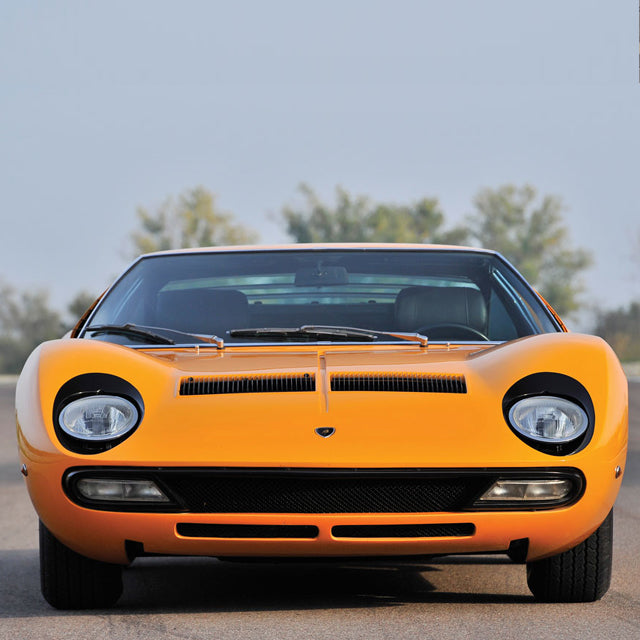Photography Courtesy of RM Sotheby's
Enzo Ferrari reportedly claimed the Jaguar E Type was, “The most beautiful car ever made,” but did anyone ask him if he’d changed his mind after the Lamborghini Miura debuted? I know, I know. It’s not like Mr. Maranello would have admitted it anyway, but it’s something that always comes to mind when I see a Miura.
Debuting in 1966, the mid-mounted transverse V-12-powered Miura elevated the standard of performance lunacy while simultaneously coining the term supercar. Trendsetting designs rarely go hand-in-hand with benchmark performance figures, but the Miura managed to accomplish both, launching Lamborghini in the big leagues seemingly overnight.
As magnificent as it was, the Miura was far from perfect, but toward the end of the production run, the fighting bull marque had undergone several tweaks to iron out the flaws we all chalk up as “character” nowadays. These further developed later models were labeled Spinto Veloce models, or SV. The SV were faster thanks to larger carburetors, more linear due to advanced timing adjustments, and more neutral handling post revised suspension components. All said, the 385 horsepower SV could gallop to 60 in 5.8 seconds before getting winded at 180mph.
Making it halfway across the world and back, this 1972 Miura P400 SV has quite an unusual history. Originally sold to chic female enthusiast Anna Germani, the supercar eventually found its way to Japan where it made the cover of Super Car Revival Impression magazine (December 1990)—oddly, wearing an unoriginal red paint scheme. After lounging in a McLaren shop in Osaka, the current owner obtained the SV and proceeded with what is likely the most comprehensive Miura restoration ever consummated.



Back in Modena, the SV was offered to only the most qualified craftsman—many of which were previously employed by Lamborghini. Carrozzeria Sports Cars, founded by Formula One driver Piero Drogo, was tasked with disassembling the complete “807”-numbered body panels. After a down-to-metal water cleaning strip treatment, Bachelli & Villa Autosport perfected the factory metalwork before returning the panels to Carrozzeria for paint. Resprayed back to the SV’s original ‘Giallo Miura’ orange zest, previous Lamborghini factory supply craftsman Bruno Paratelli reupholstered the cabin to its former Nero leather spec.
After the original chassis manufacturer Marchesi inspected the bones, a certificate affirming the chassis’ specifications checked out perfectly. Finally, Top Motors Di Salvioli L., a 30-year Lamborghini developmental department veteran, rebuilt the drivetrain. As a later SV, the original split-sump oil engine and transmission distribution system is still in place—one of the more significant mid-cycle alterations to the Miura design.
At this point, I assume it’s not surprising to hear that former chief Lamborghini test driver Valentino Balboni peered over every aspect of the restoration, down to sourcing the period-correct Pirelli CN12 tires.
Unsurprisingly, the entire reconstruction was fanatically documented with invoices and photo albums documenting the entire process. To claim this is simply a restoration would be a paradox—we should all just be grateful that feats of such grandeur occur. The owner’s handbook, jack, and factory tool kit are included…they’ll probably even throw in a tank of gas if you want to rocket your new supercar through Manhattan.



History
- Final Miura production year
- Restored by Carrozzeria Sports Cars (Piere Drago)
- Original metalwork “massaged” by Bachelli & Villa Autosport
- Restoration overseen by Valentino Balboni
- Cover feature on Super Car Revival Impression (December 1990)
Specifications
~385 horsepower, 3,929-cc DOHC transverse mid-mounted alloy V-12 engine with four Weber twin-choke carburetors, five-speed manual transmission, independent front and rear suspension with A-arms, coil springs with tubular shocks and anti-roll bars, and four-wheel hydraulic disc brakes. Wheelbase: 98.42 in.
Vehicle information
Body No.: 807
Chassis no.: 5014
Engine no.: 30700
Valuation
Auction house: RM Sotheby's
Estimate: $2,200,000-$2,600,000 Usd.
Price realized: TBD; Auction on December 10

























































